How to Reduce Negative Associations with Food & Feeding for Your Baby
In this episode we're talking about:
- What negative associations with food and feeding are and how to avoid then
- How to reduce choking risk, vomiting and anxiety associated with BLW
- Why letting your baby get messy is part of the full sensory experience of learning how to eat
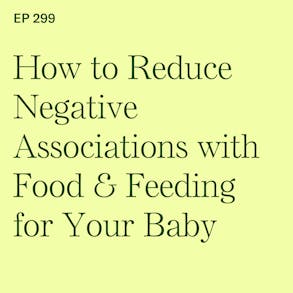
LISTEN TO THIS EPISODE
Episode Description
How can I help my baby have a positive relationship with food? And what should I avoid to help reduce negative associations with food and feeding for my baby? In this episode we’re going through some easy ways to help reduce vomiting, choking, anxiety and stress at mealtimes so that your baby can have the most positive eating experience possible.
Links from this Episode
- Online CPR Class - use affiliate discount code KATIE10 for $10 off this infant refresher CPR course: https://courses.thrivetraininginstitute.com/pages/babyledweanteam
- Bapron Baby - best bibs for baby-led weaning and splash mats to go under the high chair, use affiliate discount code KATIE10 for 10% off, shop here: https://bapronbaby.com/discount/katie10
- Baby-Led Weaning with Katie Ferraro program with the 100 First Foods™ Daily Meal Plan, join here: https://babyledweaning.co/program
- Baby-Led Weaning for Beginners free online workshop with 100 First Foods™ list to all attendees, register here: https://babyledweaning.co/baby-led-weaning-for-beginners
Other episodes related to this topic:
- Episode 20 - Vomit: What if My Baby Vomits when Eating? https://blwpodcast.com/episodes/20
- Episode 77 - Baby Hunger & Fullness Cues: What They Are & How to Spot Them https://blwpodcast.com/episodes/77

Latest Episodes

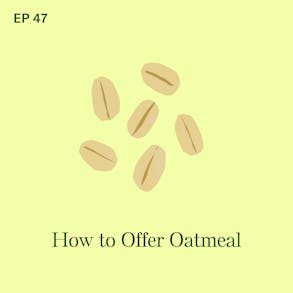

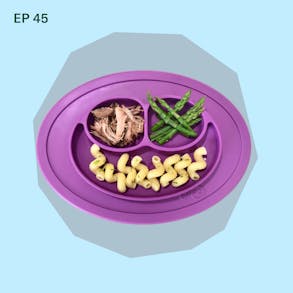
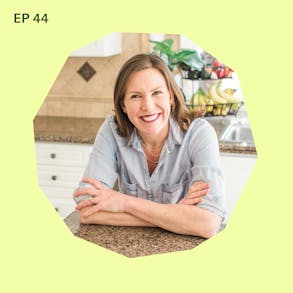
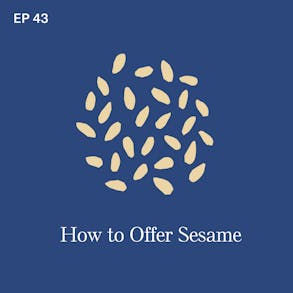
Katie Ferraro (26s):
And your baby's learning how to eat a new food. Like let's say it's buckwheat cereal and some of it falls off the spoon on the side of their mouth. Don't immediately go after them with your wet wipe or your washcloth. Like how would you feel if you were trying to learn how to eat oatmeal? And this lady's like constantly wiping you with her wet wipe or her washcloth, right? Learning how to eat is a full sensory experience. And that food dribbling down the side of the mouth, it might bug the heck out of you, but it's actually a very important part about learning how to eat. Heck yeah, clean the food mess up as soon as the meal is done, but really try to refrain from wiping your baby during the mealtime, as that can be a very negative sensory experience for your baby Hey there. I'm Katie Ferraro, registered dietician, college nutrition professor and mom of seven specializing in baby-led weaning here on the baby-led weaning Made Easy podcast I help you strip out all of the noise and nonsense about feeding, leaving you with the confidence and knowledge you need to give your baby a safe start to solid foods using baby-led weaning.
Katie Ferraro (1m 29s):
Well, hello there. welcome back. In today's episode, we're gonna be talking about negative Associations with food and Feeding your baby and what you can do to help reduce these negative Associations Now I. Like to start out each of these baby-led weaning mini training episodes with a tip of the day. And today's tip is always remind yourself that you have six months to help your baby learn how to eat. Cause sometimes parents are like, my baby's six months of age and you be getting all their nutrition from food. No, that's not how it works. You have been given this gift of the Weaning period from six to 12 months with lots and lots and lots of opportunities for your baby to learn how to get good at eating and how to get more of their nutrition from food and less from Infant milk.
Katie Ferraro (2m 9s):
That's Weaning in practice. But if you've had a bad meal or you've had a bad string of meals or a bad day or a bad week, I do not want you to think you are a failure at Feeding. Okay? It is rare that one isolated incident would forever set the stage for your baby's opinions about food. Now, I hear from moms all of the time who are so scared of, they'll use the word scarring. I don't wanna scar my baby. I did this, did it scar my baby. And they're, they're thinking, gosh, I did this thing that caused my baby to have a negative association with food and Feeding. I actually just did a parent call earlier today with a mom. There's seven month old baby, she lives in Germany. The baby was sick, the baby was vomiting. She said, when I started solid foods, they just started like two weeks ago when the baby was just sitting up on their own.
Katie Ferraro (2m 52s):
The baby had happened to have been sick. And so the baby was vomiting and the mom was like, I know it was the food that caused the baby to Vomit. We're talking about all the symptoms like, like the baby was definitely sick outside of starting solid foods and the mom felt like, oh my gosh, this baby is gonna hate eating for the rest of their life because I started solid foods on the week that he was vomiting. Okay, you have this six month grace period, this Weaning period. Don't stress yourself out about a bad day or a bad meal or a bad week. Okay? In today's episode, I wanna go through just a couple little tips that you might keep in the back of your mind as practices to avoid in order to help reduce negative Associations with food and Feeding. So let's start talking about vomiting, okay? Because there is going to be, if you're doing baby-led weaning, perhaps a few vomiting incidents, okay?
Katie Ferraro (3m 35s):
Yeah. Your baby's gonna Vomit if they're sick, okay? And, that has nothing to do with the foods that you're Feeding. But occasionally a baby will Vomit because they have a particularly involved gag as they're learning how to eat. And if their belly is full of food, that gag could induce the vomiting experience. It actually, one of the most downloaded episodes of this podcast is episode number 20. It's called vomiting and it's about Vomit and week after week where so many, so many people go back and listen to that episode. But just so you know, there is some vomiting that may occur, okay? I would say in a typical neurotypical healthy child starting solid foods, six months of age full term, your baby might throw up two or three times over the course of baby-led weaning over the six month course of transitioning to solid foods.
Katie Ferraro (4m 16s):
Okay? If your baby's vomiting every meal or every day, that's definitely not typical, okay? So I just want you to know what typical versus atypical expectations for Vomit is. But one thing you can do, especially for those babies that have particularly sensitive gag reflexes, and you know your baby said this is you, the baby still is gagging on their pacifier at three and four months of age for your baby. When you start solid foods, there will be some gagging. And perhaps you've learned that gagging is a natural and necessary part of learning how to eat. But one thing you can do if you're bottle Feeding your baby, is to build in a pad between the end of the milk feed and the start of the solid food feed. Okay? This is for babies. Again, bottle fed babies tend to consume volume-wise more than breastfed babies.
Katie Ferraro (4m 56s):
Okay? I've worked with breastfed babies at like, they'll have a breastfeeding snack sit down in the chair, gag like crazy, and they're not gonna Vomit. Okay? Now, some babies, particularly sensitive gag reflex, if they just had some breast milk, they might Vomit a little bit of it. But I'm talking about the babies with six ounces of milk in their belly from a bottle. You put them right down at the table, they're trying a new meat, they gag on it, that milk is gonna come right back up. So you can try to build in a gap of about an hour between the end of that bottle feed and the beginning of the solid food feed. If you're finding that your baby's vomiting, there's other babies with the belly full of milk that'll gag and not throw up. But if you're seeing more vomiting, more frequently vomiting than you would expect, take a look at the baby's milk situation and is there too much Infant milk in the belly?
Katie Ferraro (5m 38s):
And is that problematic? And do we need to build in a little bit of time in order to let that milk empty, to help the baby digest, to get some of that milk outta the belly, So it. If they gag, it's not coming right back up as Vomit. All right? Another thing that we can do to help reduce negative Associations with food and Feeding is that we do know that babies who have had choking incidences are at times turned off by food for a significant period of time. Okay? This is not typical, but cuz obviously choking is not typical. Choking is a very rare but real risk. I teach a lot about reducing the risk of choking because we know that there's no higher risk of choking when you start solid foods with a baby-led approach compared to traditional spoon Feeding.
Katie Ferraro (6m 20s):
But that only holds true if the parents are educated about reducing choking risk. So perhaps you've learned in the podcast or in some of my other materials that your baby's feet resting flat on a solid footplate is incredibly important for reducing choking risk. Take a look at your high chair where your baby's feet fall. Do you need to do some DIY work to get your baby's feet resting flat on that foot plate? If you have an adjustable foot plate, put it up so your baby's feet are resting flat, safe, I chair positioning to reduce choking risk involves what I call the three by 90 setup. We want your baby's waist at a 90 degree angle, their knees at a 90 degree angle and their ankles at a 90 degree angle. Okay? And so you may have to do some adjustment where you push your baby's bottom forward, you roll up a blanket or a a dish towel and prop them so that their back is straight.
Katie Ferraro (7m 6s):
You gotta get those knees bent, okay? They can't be sticking straight outta the highchair. The feet have to be resting flat on the footplate. You can do things like adding a yoga block and affixing it with a bungee cord was one we saw the other day, or Amazon boxes stacked whatever you need to do. Phone, books, textbooks to make your baby's feet resting flat. Okay? That's very important. I also teach a lot about preparing the food safely for baby-led weaning. We want soft pieces of food in strips or spheres about the size of your adult pinky finger. Then I'll show you more about what the first, especially the first 10 days of baby-led weaning, what you might expect it to look like. That's all on a free video workshop that I teach called BABY-LED WEANING FOR BEGINNERS.
Katie Ferraro (7m 46s):
So if you haven't taken that free online workshop yet, that's the one where I give everyone on that workshop a copy of my hundred FIRST FOODS list. I'm gonna walk you through the first 10 days, show you how to prep the foods. You can sign up for this week's workshop times at baby-led weaning dot co. We spend a lot of time there talking about reducing choking risk so that your baby doesn't have a choking incident that would then potentially turn them off of food and Feeding. Hey, we're gonna take a quick break, but I'll be right back.
Katie Ferraro (8m 48s):
Another thing you can do to reduce negative Associations with food and Feeding for Your Baby is to create a stress free Feeding environment. Now I I. Know that is easier said than done But. it is true that our children and even infants can sense stress and one of the things that parents are most stressed about when it comes to starting solid foods is choking. And what do I do if my baby chokes? So I would really encourage you to also take a refresher Infant CPR course. I know you all took Infant CPR before your baby was born, but that was six months ago. I can't even remember what I had for breakfast yesterday, let alone the particulars of an online class I took six months ago. So I do take an online CPR course, I take that every single quarter. It's an absolutely fabulous experience.
Katie Ferraro (9m 29s):
I am an affiliate for the same program that I take, and I do have a code for $10 off. I think the course is $35, but with the code KATIE10, it will take an additional $10 off. I'll put the link to that online CPR course in the show notes. You can find that at blwpodcast.com/299 or tap where you are listening to the podcast and you can link out to take that online CPR course because again, no higher risk of choking with baby-led weaning compared to traditional spoon Feeding. However, you have to know how to reduce choking risk. And in the event that your baby chokes, I want you to know CPR because CPR can save your baby's life. A few other mealtime like in the mix, things that you might want to steer clear of.
Katie Ferraro (10m 9s):
The first one is kind of not related to baby-led weaning because it involves traditional spoon Feeding. But I sometimes see parents spoon Feeding babies, like if you're out and about at a restaurant, my husband's like, stop staring at that family. I'm like, I'm just interested in how this works. Scraping the side of the baby's mouth with the spoon is like nails on a chalkboard to me. First of all, we don't need to be putting anything in a baby's mouth because putting anything in a baby's mouth, including a spoon, can be a choking hazard. But with traditional spoon Feeding, when the parent fills up that big, large, bold spoon shoves it in the baby's mouth and then some of it gets on the side of their mouth, then they go scrape it with the side of the spoon. That's an incredibly negative sensory experience for your baby. Okay? Learning how to eat involves all of the baby senses, and yes, getting messy is part of learning how to eat, but it's important for your baby to experience.
Katie Ferraro (10m 55s):
What does it feel like when the food dribbles down the side of my face or I'm drinking outta the open cup and some of the liquid goes down the other side of my face, I need to make adjustments and make corrections so that the next time I don't have this uncomfortable feeling, we're always cleaning up for them. We're not allowing baby to have the full sensory experience that is learning how to eat. So another one is trying not to wipe your baby while the baby is eating. Okay. So we see parents who can't even handle the mess and oh my gosh, they're eating oatmeal and some of it fell on their face and they get my wet wipe or my washcloth. Like, how would you feel if you were trying to learn how to eat oatmeal? And this lady is like constantly coming at you with her washcloth or her wet wipe. Okay, again, allowing baby to experience the mess is part of that whole sensory experience that is learning how to eat.
Katie Ferraro (11m 36s):
I'm all for cleaning up the mess the second the meal is over. Cuz my preferred baby-led weaning setup is I do a splash mat underneath the highchair, put the highchair on top of the splash mat. I used to splash mat from a company called Bapron Baby. They have these big huge waterproof splash mats that that go underneath the high chair, catch the food, don't step on the splash mat, pick the food up off the clean splash mat. I'll put it back up on the table on the plate about three times and then I'm like not gonna do it anymore after that. But I love the splash mat approach because it allows me to recycle some of that food back up. If the baby is getting messy on the floor, I want them to actually eat that food. But then at the end of the meal, I reach over, I get the baby out of the height chair, take 'em over to the faucet, run lukewarm water.
Katie Ferraro (12m 17s):
Then I just use my hand to cut the water, wash their face off, wash their hands off, I'll put them somewhere safe to sit and then I go right to cleaning up that wet baby-led weaning food mess because agreed, like dried baby-led weaning food mess, especially dried oatmeal, dried yogurt, such a pain to clean, but don't clean it while your baby's eating. Alright? Another one that I see sometimes that I think is a negative experience for your baby is when we feed our babies naked in a drafty environment. Okay? If wherever you live, you eat naked, more power to you. But a lot of times I'm like seeing the baby sitting there naked again, the family being fearful of the mess, Feeding the baby naked if it's cold, if it's drafty, that could be a negative sensory experience for your baby.
Katie Ferraro (12m 59s):
So I recommend using a baby-led weaning bib. The bibs I like are from the same company that makes the splash mat. It's called bapron baby. So a bapron is like a hybrid between a bib and an apron. And the bapron bibs are great for baby-led weaning because they do not cover your baby's shoulders. They do not restrict their range of motion, okay? I do not like those big large tent like contraption bibs that go over the table or over the tray and the baby can't move their arms freely. I love the Bapron baby bibs because they're, it's kind of like a wide tank top style and they tie in the back underneath the baby's shoulder blade So. It's a really nice sensory experience versus some of those other bibs that go all up in your baby's neck. As they get older, they start pulling those bibs and can rip 'em off.
Katie Ferraro (13m 40s):
The bapron ones are awesome because of the way they tie, again, better sensory experience that they're not choking your baby off at the neck, but also your baby can't pull them off as they get older. And the material that the bapron bibs are made out of is waterproof. So you can just rinse it underneath the faucet, put it on your drain board, and it's ready for the next meal. So you don't have to like do laundry in between meals if you only have one bib. So I am an affiliate for BApron baby. It's the company that makes the splash mats and the bibs. I recommend getting a couple of their, they're called the toddler bibs. It's kind of confusing. The Toddler Bapron baby bib is for six months to, they say three years, but I've never had my babies fit in those after two years. They have a bigger size called preschool that I start using at about two.
Katie Ferraro (14m 20s):
But if you're just starting with solid foods, get a couple of the Bapron, baby toddler bibs, those are for six months of age, and my code KATIE10 works for 10% off @ bapronbaby.com, grab one of their splash mats. And I think that that's by far the best bib out there, both from a developmental standpoint, the material, I've had some of my bibs for seven years at this point, and they look as good as they did the day that they were new. So I think it's worth investing in one or two good bibs versus a bunch of crappy ones that you're gonna end up throwing out. Hey, we're gonna take a quick break, but I'll be right back.
Katie Ferraro (15m 58s):
All right? So don't wipe your baby's face during mealtimes. Don't feed your baby naked if it's drafty. If you're doing spoon Feeding, you should be putting the preloaded spoon in your baby's hand and let them bring it to their mouth. That's the baby-led approach to spoon Feeding. But if that happens, do not use the spoon to then scrape the food off the side of your baby's mouth. Another one is, don't force your baby to eat an arbitrary amount of food. Sometimes his parents would worry, oh my gosh, my baby's not getting enough. I hear that a lot. Oh, the baby's not getting enough, so I'm gonna make them finish this pouch, or I'm gonna make them finish this amount of the bottle. Okay? The whole point of the baby-led approach is that we're allowing the baby to drive the eating experience. So don't feel stressed that you need to make an arbitrary amount of food and then make your baby eat it.
Katie Ferraro (16m 44s):
Okay? Another really popular podcast episode with high downloads that we see week after week is episode 1 0 8. It's called Portion Distortion. Why? There aren't set portion sizes for baby-led weaning. Okay? If you're seeing things online, your baby needed to eat one ounce of whole grain and two tablespoons of not butters or whatever it is, please know that all of those portion sizes are arbitrary. They are contrived, they are made up out of thin air, okay? There is no set amount of food that your baby needs to eat, so don't feel that you need to pressure your baby into eating X amount of that food, okay? That can cause us to teach our babies very quickly to override their own internal satiety and Hunger Cues, and then all of a sudden they're just little versions of us, which sometimes we don't listen to our internal Hunger and satiety Cues, right?
Katie Ferraro (17m 29s):
Babies are born with the ability to know when they're full, right? That's why they push their face away from the breast or the bottle when they're done, bottle Feeding or breastfeeding. And as you transition into solid foods, watch for your baby's Cues. Okay? Another great episode to listen to if you're like, I don't know what Hunger and Fullness Cues look like. Go back to episode 77. It's called Baby Hunger and Fullness Cues What They Are, and how to spot them. Okay? Because we wanna be honoring our baby's Cues. They're trying to tell us non-verbally when they're full and when they're hungry, and we don't wanna override those Cues. We want our baby to learn how to listen to those Hunger and Fullness Cues as they're learning how to love food, just like hopefully you love food. So just a few tips there.
Katie Ferraro (18m 9s):
How to Reduce, Negative Associations with Food and Feeding your baby. To summarize, in order to reduce the likelihood of vomiting, try to build in that gap from the end of the bottle feed towards the beginning of the solid food feed. Some babies need around an hour, although some babies do better with less time to reduce the likelihood of choking, make sure that your baby's feet are rested flat on a solid foot plate. You can learn more about prepping safe foods on that free one hour video workshop I teach called BABY-LED WEANING FOR BEGINNERS. You can sign up @ "babyledweaning.com". That's also where you grab your copy of my hundred FIRST FOODS list so you'll never run out of ideas of foods your baby can eat. Again, that's at baby-led weening dot co. In order to help yourself be less stressed at mealtime, make sure that you know basic Infant refresher CPR skills.
Katie Ferraro (18m 53s):
Take an online CPR course. I'll link to the course that I recommend, along with the discount code in the show notes, and then try not to wipe your baby's face during mealtime. Try not to feed them naked, especially if it's drafty. Get some good bibs. I like those ones from bapron, baby plus their splash mats. And then don't force your baby to eat an arbitrary amount of food. The show notes of this episode are at blwpodcast.com/299. I'll link to all of the other episodes I talked about, plus, put the links to some of the products that I mentioned all at blwpodcasts.com/299. I also wanted to say thank you to our partners at AirWave Media. If you guys like podcasts that feature food and fun, and using your brain, check out some of the other podcasts on the AirWave Media Network.
Katie Ferraro (19m 36s):
We're online @ blwpodcast.com. Thanks so much for listening, and I'll see you next time.

The Program Baby-Led Weaning with Katie Ferraro
A step-by-step digital program for starting solid foods safely and navigating the original 100 FIRST FOODS™ meal plan with baby-led weaning.
 EXPERT-LED, PROVEN APPROACH TO EATING REAL FOOD
EXPERT-LED, PROVEN APPROACH TO EATING REAL FOOD CONCISE VIDEO TRAININGS TO MASTER BABY-LED WEANING
CONCISE VIDEO TRAININGS TO MASTER BABY-LED WEANING 100 FIRST FOODS DAILY MEAL PLAN WITH FOOD PREP VIDEOS
100 FIRST FOODS DAILY MEAL PLAN WITH FOOD PREP VIDEOS
Baby-Led Weaning for Beginners Free Workshop
Is your baby ready to start solid foods, but you’re not sure where to start? Get ready to give your baby a solid foundation to a lifetime of loving real food…even if you’re feeling overwhelmed or confused about this next stage of infant feeding.
Get baby-led weaning recipes and tips delivered to your email inbox.

